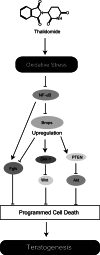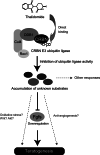Teratogenic effects of thalidomide: molecular mechanisms
- PMID: 21207098
- PMCID: PMC11114848
- DOI: 10.1007/s00018-010-0619-9
Teratogenic effects of thalidomide: molecular mechanisms
Abstract
Fifty years ago, prescription of the sedative thalidomide caused a worldwide epidemic of multiple birth defects. The drug is now used in the treatment of leprosy and multiple myeloma. However, its use is limited due to its potent teratogenic activity. The mechanism by which thalidomide causes limb malformations and other developmental defects is a long-standing question. Multiple hypotheses exist to explain the molecular mechanism of thalidomide action. Among them, theories involving oxidative stress and anti-angiogenesis have been widely supported. Nevertheless, until recently, the direct target of thalidomide remained elusive. We identified a thalidomide-binding protein, cereblon (CRBN), as a primary target for thalidomide teratogenicity. Our data suggest that thalidomide initiates its teratogenic effects by binding to CRBN and inhibiting its ubiquitin ligase activity. In this review, we summarize the biology of thalidomide, focusing on the molecular mechanisms of its teratogenic effects. In addition, we discuss the questions still to be addressed.
Figures




References
Publication types
MeSH terms
Substances
LinkOut - more resources
Full Text Sources
Other Literature Sources

